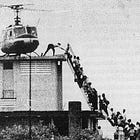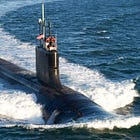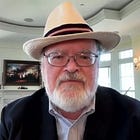Truman Was Right - The 80th Anniversary of Hiroshima
Whether judging by necessity or Just War Theory, the Allies, however imperfect, were righteous in waging this defensive war and right to use the Atomic Bomb to end it. Here's why.
Our Deep Dives are normally for Premium Members only, but we think this one is so important that we’re presenting it for FREE. Join Premium today.
by Rod D. Martin
August 6, 2025
Eighty years ago today, the United States dropped the first-ever atomic bomb used in combat on Hiroshima, Japan. Three days later, it dropped the second on Nagasaki.
For decades since, revisionists (and anti-Americans, who are not at all necessarily the same thing) have criticized President Truman’s decision as unnecessary, monstrous, or both. Some of these people are good friends of mine, unquestionably patriotic, and in some cases, seeking to apply Christian teaching to the situation.
I respect them. But I respectfully disagree. Hiroshima was both legitimate and necessary. The contrary position is simply ahistorical, devoid of context.
War is awful. But even Just War Theory teaches us that war is sometimes necessary, especially when it is forced upon you. Hiroshima was but one battle in history’s most destructive war.
And winning such a war is good and right.
Moreover, lest we forget, in 1945 there was no Iron Dome. There was no GPS. There were no precision drone strikes taking out a single targeted enemy on the third floor. There were only imprecise mass weapons in a battle to the death with an enemy that had demonstrated a savagery unknown since the days of the Aztecs or Genghis Khan.
It had demonstrated that murderousness consistently and relentlessly against civilian populations, not least in killing and raping its way through 300,000 unarmed victims — old men, women, children — in the Chinese capital Nanking, or in its execution of over 250,000 Chinese civilians it thought might, might, have participated in hiding the Doolittle Raiders.
Ultimately, even after the atomic bombings, the Japanese killed seven times as many people as they lost. Let that sink in.
Years before Hitler invaded Poland, it was not Germany but Japan that started the war. Its goals were conquest, of everything it could reach. All must serve the Emperor, son of the sun goddess. All non-Japanese were some degree of subhuman, to be treated as the dogs we are: just ask the Korean “comfort women”, or the survivors of the Bataan Death March. The Japan of the 1930s and 40s almost made Germany seem civilized. It was a scourge upon the Earth. One cannot with a straight face claim that Hitler had to be removed from power “no matter the cost” while pretending the Japanese regime could be allowed to continue.
So the Americans concluded they had to repeat D-Day: invade the Home Islands, drive to Tokyo, end the nightmare. If they didn’t, why did they not stop at Germany’s border and leave Hitler in power as well? And if the Nazi and Japanese regimes were allowed to survive, how long until the world was at war for a third time in two generations?
Yet the closer we got to Japan itself, the clearer the danger of that strategy became.
In the Battle of Luzon, Japanese forces were so furiously tenacious that, of 250,000 men, they lost 205,000 and still would not surrender. Luzon was occupied territory, not their Home Islands. There they intended to fight to the very last man, had prepared for this far better than the Allies had realized at the time — so much so that there's a good chance the planned invasion could have failed — and left in this state, would have resumed offensive operations at the soonest possible opportunity.
At Okinawa, the Japanese fought even harder, far beyond any rational possibility of victory. But the real horror was what the Japanese did to their own. The military ordered civilians to resist or die: mothers jumping off cliffs with babies, entire families committing suicide rather than face capture, countless civilians used as “human shields”, all while unleashing ever-increasing swarms of suicide bombers — Kamikaze — warplanes transformed into guided missiles, in many cases “manned” by children and disabled people strapped into their cockpits.
The U.S. commanders were shocked at what they saw. On Okinawa especially, they had won, but they were shaken by it. The planned invasions of the Japanese Home Islands promised to be orders of magnitude worse, for America as well as for the Japanese.
So Truman ended Japan’s war. In one instant, he did what years of combat, blockades, and a million Allied deaths could not. He saved at least 10 million Japanese, not to mention countless Chinese, Koreans, and Filipinos, mostly civilians, at a cost of less than half the lives lost just at Nanking. He crushed a god-emperor cult that demanded every man, woman, and child die in glorious resistance. And he gave Japan something it had never known: peace.
That’s not a war crime. That’s a gift to the world.
We ought not judge Truman by our anachronistic standards. He did not have our luxuries. He made the best decision he could with the facts he had. And by any reasonable standard, I contend his decision was right.
Hiroshima and Nagasaki Were Military Targets
The claim is often made that Hiroshima and Nagasaki were “innocent” population centers. But that’s simply not the case.
Hiroshima was a major military hub. It housed the headquarters of Japan’s Second General Army, responsible for defending southern Japan (the target of the coming invasion). It also contained large military supply depots, assembly areas, and industrial facilities supporting the war effort. Roughly 43,000 soldiers were stationed there at the time of the bombing.
Kokura was the original target for the second atomic bomb but was spared due to poor visibility from smoke and cloud cover. It was a major military center, home to the Kokura Arsenal, which produced rifles, machine guns, and other weapons for the Imperial Japanese Army. The city also housed facilities for the production and maintenance of tanks, chemical weapons, and munitions, and served as a key logistical hub for transporting troops and supplies. Its concentration of critical military industry made it a prime target.
Nagasaki was a secondary target, struck after the bomber crew waved off from Kokura. Nagasaki was an important shipbuilding and industrial center, home to the Mitsubishi Steel and Arms Works, which produced torpedoes, ships, and other war materiel. It was also the most important military port on the southernmost Home Island, Kyushu, which was to be the first such island invaded.
Some rightly point out the tragedy that Nagasaki was the center of Japanese Christianity. They sometimes further note, as I have, that in the years after, Democrat Presidents (Truman) sold out our Christian ally Chiang Kai-shek (President of the free Republic of China), and (JFK) allowed the assassination of our Christian ally Ngo Dinh Diem (President of the free Republic of Vietnam). There’s no question the pattern is disturbing: it certainly disturbs me. But in the context of 1945, Nagasaki was a legitimate military target, and it was almost certain to face destruction one way or another.
To the Planners, the Bomb Was…Just A Bigger Bomb
There were no precision weapons in 1945. War was fought with blunt instruments. “Smart bombs” would have been seen as a fantasy. Targeting capabilities were minimal. Success required dropping a lot of bombs in the general area of the target and hoping some actually hit it.
America’s moat — the Atlantic and Pacific Oceans — largely spared it of this, thanks to the limited range of the era’s weapons. America’s Allies were not so blessed, bludgeoned and bloodied from the beginning to the end.
The problem was simple: factories and bases are in or near cities. They have to be. Where defeat means not a negotiated peace but slavery and death, both sides had to destroy that capacity. The difference? Germany and Japan were the aggressors, not the victims.
To listen to some of our revisionist friends, one would think they’d deem fighting back against a rapist to be sinful. I respectfully but strongly disagree.
By August 1945, fleets of bombers had done their worst to destroy Rotterdam, London, Hamburg and Tokyo. The Nazis intentionally engaged in terror bombing. The Allies attempted precision bombing of military targets, but were greatly limited by the technology of the time. Collateral damage was unavoidable if these targets were to be attacked at all.
I repeat, the Allies didn’t start the war, nor could they hope to end it but by winning it.
But the truth is, the Allies got very good at waging it. The firestorm at Hamburg, like the death toll at Tokyo, was greater than that at either Hiroshima or Nagasaki. And yet both German and Japanese war production continued to rise steadily until the very last months of the war. Without the bombings, it would have become overwhelming: the Axis would have won.
In this context, the atomic bombs were viewed as “just a bigger bomb”. It carried no unique moral qualms. We mythologize nuclear weapons, in part because ours are many times more destructive than those used against Japan, and in part because many of us lived through an era in which “the end of the world as we know it” was an ever-present possibility. But to the Allies, A-bombs were just a more efficient way to do the same thing: one bomb on one plane instead of thousands of both. And ironically, had we used one on Tokyo rather than the conventional weapons we actually used, the death toll there would have been significantly reduced. 90,000 died at Hiroshima, 60,000 at Nagasaki. 100,000 had died at Tokyo, 300,000 at Nanking (mostly hand-to-hand).
This is why planners intended to use atomic bombs to “clear” the Japanese beaches ahead of our invasion (did I mention their somewhat limited understanding of the effects of radiation?). For that matter, this is why the U.S. Army subsequently developed and deployed tactical nuclear weapons, similar in explosive power to the Hiroshima bomb (though in many cases a bit smaller), for use against massed Soviet armored formations which might flood through the Fulda Gap in some future war. These are not the bombs we imagine destroying civilization, nor did Truman’s generals imagine such.
Indeed, much post-war (but pre-H-bomb) fiction recounts a future atomic war in the recent past of the protagonists, more destructive than World War II but still “just another war”. Standout examples include Orwell’s 1984 and Heinlein’s The Man Who Sold the Moon. Fusion devices changed all that (hence Pat Frank’s excellent Alas, Babylon , or Nevil Shute’s truly awful On the Beach, just a few years later). But the H-Bomb — much less tens of thousands of them delivered in mere minutes by intercontinental ballistic missiles — was unimaginable at the time.
Far sooner was the Truman Administration’s realization of the A-bomb’s potential for “shock and awe”. Before the Trinity test in July 1945, no one had ever seen such an explosion, nor fully grasped the awe it could inspire. Afterward, Truman’s team became convinced that there was at least a chance the Japanese could be shaken out of their inertia and monomaniacal focus on fighting to the death.
In that, they proved correct.
Was Japan on the Brink of Surrender?
Another revisionist position, endlessly repeated, is that by August 1945 Japan was “already defeated.” But in truth, Japan’s war machine was not only still running — it was ramping up.
Like Germany before it, Japan had learned to disperse and harden its production. Incredibly, both the German and Japanese war economies continued to increase production well into 1945, even under constant bombardment. And unlike Germany, Japan still had vast forces intact across China, Indochina, Korea, and Manchuria — millions of well-armed, well-supplied troops in occupied territory, undeterred and in many cases untouched.
These armies weren’t waiting to surrender. They were waiting to fight.
And fight they would have. The planned invasion of the Japanese Home Islands — Operation Downfall — would have made Luzon, Iwo Jima, and Okinawa look like a skirmish. Truman had in front of him estimates of over a million Americans and ten million Japanese dead. And these numbers weren’t speculative. They were based on real engagements, on real Japanese tactics, and on the disturbing willingness of an entire nation to die for the Emperor.
Or to put that another way, the Pentagon was so convinced of these numbers that it ordered a million and a half Purple Hearts, so many that we’re still using them eight decades later.
The Japanese had spent years preparing a civilian-based resistance. They had no intention of surrender. They were booby-trapping every cave as they had on Iwo Jima; they were training schoolgirls with spears as they had on Okinawa. Would a culture fixated on ritual suicide go ahead with such plans? It had already.
Unlike in Germany, the cost of invasion would have been genocide. This horrified Truman’s men.
They similarly rejected the idea, especially popular today with the academic left and the libertarian right, that we should have simply blockaded Japan, “starved them out,” and waited.
But this is not “moral”. Indeed, this may be the most monstrous argument of all.
In Washington’s view, starvation wouldn’t bring surrender. It wouldn’t even diminish Japanese forces. The Army had priority in food distribution. Deaths would concentrate among the elderly, the sick, and the children.
Millions of them. Again, genocide.
Moreover, ever-increasing Kamikaze attacks meant that a blockade would put the U.S. Navy at enormous risk, for an open-ended commitment with little hope of success. How many American sailors would have to die to maintain this porous, ineffective action, only to watch the Soviets — who had already lost 20 million soldiers (vs. our 450,000) and were willing to accept many more — invade and finish the job we’d left undone?
Truman did not see any of this as acceptable.
The revisionists generally accept the point with regard to Germany, but had the German and Japanese regimes not been removed, whatever the cost, the war would surely have resumed, more destructive than before. This had already happened in the Allied leaders’ lifetimes. Moreover, both regimes understood the principles behind atomic weapons and were actively seeking to create them. Given time and breathing space, the Soviets developed theirs within four years of the end of the war, giving some indication of the longevity of a negotiated “peace”. You could finish Germany and Japan now, or you could fight them again later. But a future fight might prove final, and fatal.
This is the choice Truman faced. He didn’t hesitate.
The Bomb Saved Japan
Even after the first bomb, even after Hiroshima was obliterated, half the Japanese leadership still refused to surrender. They were fully prepared to sacrifice the civilian population to preserve their “divine” Emperor’s regime. It took not just Hiroshima but Nagasaki to force the decision for peace.
That decision didn’t just end the war. It saved Japan.
The shock of atomic defeat broke the spell of imperial mythology. It gave moderates the leverage to end the madness. It forced the Emperor to confront reality. And it gave America the opportunity to reshape Japan, not through vengeance, but through reconstruction. What followed wasn’t punishment. It was peace. It was dignity. It was liberty.
The prosperous, free Japan of today would be utterly unimaginable to the Emperor’s subjects in 1931 or 1945.
Japan didn’t become a smoldering wasteland or a Soviet slave state. It became an ally. A democracy. A powerhouse. Hiroshima and Nagasaki, far from being monuments to ruin, are today bustling cities, filled with life. That’s not because we withheld the bomb. It’s because we used it, and then had the moral clarity and civilizational charity to rebuild what we had broken, better than before.
The tragedy, if anything, came afterward — not from the use of force, but from our failure to follow through.
America disarmed too quickly. And in a fatal act of diplomatic betrayal, the Truman administration abandoned Chiang Kai-shek, paving the way for Mao’s bloody communist takeover of China and 65 million innocent dead. Had Truman applied the same resolve to Asia’s postwar settlement that he had to Japan’s surrender, the Cold War map could have looked very different: China a strong democratic ally, the Korean and Vietnam Wars avoided, the dangers of Soviet success greatly curtailed.
But those failures came after the victory. And the victory — delivered by the Bomb — was righteous, just, and ultimately, redemptive. It killed the fewest, spared the most, and made a very different, better future possible.
Don’t Condemn the Men Who Saved the World
FDR and Harry Truman made countless awful mistakes. I have personally spilled a lot of ink recounting them, and their ongoing harm down to this present day.
Hiroshima was not one of them.
Truman didn’t choose between good and evil. He chose between bad and worse. And in doing so, he saved countless millions. He ended a war the Allies had neither wanted nor started, and both the regimes and modes of thought that had started it. He made his decision based on what he knew at the time. And he was right.
To condemn him is to rewrite history — to pretend a world that never was and ignore the far worse one that might have been, that was frankly far more likely. It is to pretend that mass starvation is more moral than a sudden shock, that allowing Nazi Germany or Imperial Japan to continue diminished but undefeated is more ethical than decisive victory.
Hiroshima was not a war crime. It was the ending of a criminal war.
Americans have since worked tirelessly to harness technological advances so as to render such choices unthinkable, from Iron Beam and Golden Dome to precision-guided weapons that give us the luxury of thinking collateral damage scandalous and have reduced war deaths by orders of magnitude. America has shared those tools with its allies, rendering war radically more surgical, not to mention far rarer than before 1945. Indeed, the greatest guarantor, humanly speaking, of the better world we inhabit is the goodwill of the ensuing Pax Americana, in which conquest is deemed immoral, enemies are rebuilt and made friends, and no Hitler, Stalin, or Tojo can easily arise.
American hegemony may not be “fair”. But it’s right, even righteous. The world is vastly better for it.
But the men who made the decision to bomb Hiroshima did not have our luxuries. They faced existential threats that are hard for us to imagine. And it would be horribly wrong to judge them by the standards of our time, not their own.










[EDIT: in reviewing my original comment I realized that it might not be clear that I am in total agreement and have nothing but praise. My only intent is to vector the interested toward a more detailed look.]
Outstanding presentation. You have done a magnificent job summarizing the real state of play, the options available, the capabilities of the Allies and of the Japanese. Anyone who still believes the Gar Alperovitz revisionist view should be forced to read this essay.
If I may be permitted to, I will include two links to what I consider the definitive books on the subject, both written in the late 1990s after the final batch of relevant documents were classified:
Norman Polmar and Thomas Allen's /Code Name Downfall/, <https://www.amazon.com/Code-Name-Downfall-Secret-Japan-Dropped/dp/0684804069>
Richard Giangreco's /Hell To Pay: Operation DOWNFALL and the Invasion of Japan, 1945–1947/, <https://www.amazon.com/Hell-Pay-Operation-DOWNFALL-1945-1947-ebook/dp/B07FRJGY4R>
Both are highly recommended for those who want to drill down to the truth of the situation as presented in this essay, but at a greater level of detail and with complete references.
There is a third book on Amazon which I have not read, but I add it for completeness's sake:
Richard Frank's /Downfall: The End of the Imperial Japanese Empire/ <https://www.amazon.com/Downfall-End-Imperial-Japanese-Empire/dp/0141001461>
If we had invaded and lost 50,000 lives, we would have hanged Hirohito and the Occupation would have been a bloodbath.